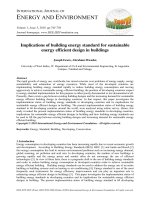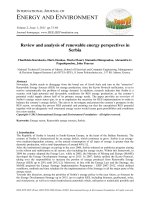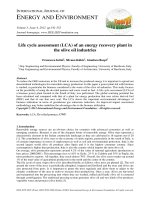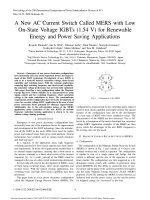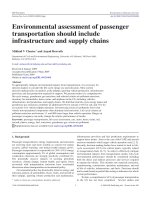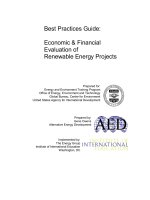Environmental impacts of renewable energy f spellman (CRC, 2015)
Bạn đang xem bản rút gọn của tài liệu. Xem và tải ngay bản đầy đủ của tài liệu tại đây (15.05 MB, 490 trang )
ENVIRONMENTAL
IMPACTS OF
RENEWABLE
ENERGY
ENERGY AND THE ENVIRONMENT
SERIES EDITOR
Abbas Ghassemi
New Mexico State University
PUBLISHED TITLES
Environmental Impacts of Renewable Energy
Frank R. Spellman
Geothermal Energy: Renewable Energy and the Environment,
Second Edition
William E. Glassley
Energy Resources: Availability, Management, and Environmental Impacts
Kenneth J. Skipka and Louis Theodore
Finance Policy for Renewable Energy and a Sustainable Environment
Michael Curley
Wind Energy: Renewable Energy and the Environment, Second Edition
Vaughn Nelson
Solar Radiation: Practical Modeling for Renewable Energy Applications
Daryl R. Myers
Solar and Infrared Radiation Measurements
Frank Vignola, Joseph Michalsky, and Thomas Stoffel
Forest-Based Biomass Energy: Concepts and Applications
Frank Spellman
Introduction to Renewable Energy
Vaughn Nelson
Solar Energy: Renewable Energy and the Environment
Robert Foster, Majid Ghassemi, Alma Cota,
Jeanette Moore, and Vaughn Nelson
ENVIRONMENTAL
IMPACTS OF
RENEWABLE
ENERGY
Frank R. Spellman
Boca Raton London New York
CRC Press is an imprint of the
Taylor & Francis Group, an informa business
CRC Press
Taylor & Francis Group
6000 Broken Sound Parkway NW, Suite 300
Boca Raton, FL 33487-2742
© 2015 by Taylor & Francis Group, LLC
CRC Press is an imprint of Taylor & Francis Group, an Informa business
No claim to original U.S. Government works
Version Date: 20140616
International Standard Book Number-13: 978-1-4822-4947-7 (eBook - PDF)
This book contains information obtained from authentic and highly regarded sources. Reasonable efforts
have been made to publish reliable data and information, but the author and publisher cannot assume
responsibility for the validity of all materials or the consequences of their use. The authors and publishers
have attempted to trace the copyright holders of all material reproduced in this publication and apologize to
copyright holders if permission to publish in this form has not been obtained. If any copyright material has
not been acknowledged please write and let us know so we may rectify in any future reprint.
Except as permitted under U.S. Copyright Law, no part of this book may be reprinted, reproduced, transmitted, or utilized in any form by any electronic, mechanical, or other means, now known or hereafter invented,
including photocopying, microfilming, and recording, or in any information storage or retrieval system,
without written permission from the publishers.
For permission to photocopy or use material electronically from this work, please access www.copyright.
com ( or contact the Copyright Clearance Center, Inc. (CCC), 222 Rosewood
Drive, Danvers, MA 01923, 978-750-8400. CCC is a not-for-profit organization that provides licenses and
registration for a variety of users. For organizations that have been granted a photocopy license by the CCC,
a separate system of payment has been arranged.
Trademark Notice: Product or corporate names may be trademarks or registered trademarks, and are used
only for identification and explanation without intent to infringe.
Visit the Taylor & Francis Web site at
and the CRC Press Web site at
As humans we tend to forget that Mother Nature does not need us
to flourish and survive; instead, we need Earth to survive, period.
To a person with a saw, everything looks like lumber.
Contents
Preface...................................................................................................................... xv
To the Reader..........................................................................................................xvii
Author......................................................................................................................xix
Chapter 1 Setting the Stage: The 411 on Energy Basics........................................ 1
Energy...................................................................................................1
Types of Energy.....................................................................................2
Nonrenewable Energy........................................................................... 3
Benefits............................................................................................. 3
Non-Benefits.....................................................................................3
Renewable Energy.................................................................................4
Benefits............................................................................................. 4
Non-Benefits.....................................................................................4
Energy Use in the United States............................................................4
Measuring Energy................................................................................. 5
Heat Engines.........................................................................................6
Rankine Cycle Heat Engine.............................................................7
Stirling Cycle Heat Engine...............................................................8
Thought-Provoking Questions..............................................................8
References and Recommended Reading...............................................8
Chapter 2 Wind Power: Where Eagles Don’t Dare.............................................. 11
Introduction......................................................................................... 11
Wind Power Basics.............................................................................. 13
Air in Motion.................................................................................. 13
Wind Energy....................................................................................... 14
Wind Power......................................................................................... 16
Wind Turbine Types....................................................................... 16
Horizontal-Axis Wind Turbines..................................................... 16
Wind Turbine Components................................................................. 18
Wind Energy Site Evaluation Impacts................................................ 19
Air Quality..................................................................................... 19
Cultural Resources.........................................................................20
Ecological Resources......................................................................20
Water Resources.............................................................................20
Land Use.........................................................................................20
Soils and Geologic Resources........................................................20
Paleontological Resources.............................................................. 21
vii
viii
Contents
Transportation................................................................................ 21
Visual Resources............................................................................ 21
Socioeconomics.............................................................................. 21
Environmental Justice.................................................................... 21
Hazardous Materials and Waste Management............................... 21
Acoustics (Noise)............................................................................ 21
Wind Energy Construction Impacts....................................................34
Air Quality.....................................................................................34
Cultural Resources......................................................................... 35
Ecological Resources...................................................................... 35
Water Resources............................................................................. 36
Land Use......................................................................................... 36
Soils and Geologic Resources........................................................ 37
Paleontological Resources.............................................................. 37
Transportation................................................................................ 38
Visual Resources............................................................................ 38
Socioeconomics.............................................................................. 42
Environmental Justice.................................................................... 43
Hazardous Materials and Waste Management............................... 43
Wind Energy Operations Impacts....................................................... 43
Air Quality..................................................................................... 43
Cultural Resources......................................................................... 43
Ecological Resources......................................................................44
Water Resources.............................................................................44
Land Use.........................................................................................44
Soils and Geologic Resources........................................................ 45
Paleontological Resources.............................................................. 45
Transportation................................................................................ 45
Visual Resources............................................................................ 45
Socioeconomics..............................................................................46
Environmental Justice....................................................................46
Hazardous Materials and Waste Management...............................46
Wind Energy Impacts on Wildlife......................................................46
Motion Smear................................................................................. 50
Law of the Visual Angle................................................................. 51
Wind Energy Impacts on Human Health............................................ 53
Power Transmission Lines................................................................... 55
Energy Transmission Site Evaluation Impacts.................................... 55
Air Quality..................................................................................... 55
Cultural Resources......................................................................... 55
Ecological Resources...................................................................... 56
Water Resources............................................................................. 56
Land Use......................................................................................... 56
Soils and Geologic Resources........................................................ 56
Paleontological Resources.............................................................. 56
Contents
ix
Transportation................................................................................ 57
Visual Resources............................................................................ 57
Socioeconomics.............................................................................. 57
Environmental Justice.................................................................... 57
Energy Transmission Construction Impacts....................................... 57
Air Quality..................................................................................... 57
Cultural Resources......................................................................... 58
Ecological Resources...................................................................... 58
Water Resources............................................................................. 58
Land Use......................................................................................... 59
Soils and Geologic Resources........................................................ 59
Paleontological Resources..............................................................60
Transportation................................................................................60
Visual Resources............................................................................60
Socioeconomics.............................................................................. 61
Environmental Justice.................................................................... 61
Energy Transmission Operations Impacts.......................................... 61
Air Quality..................................................................................... 61
Cultural Resources......................................................................... 61
Ecological Resources...................................................................... 62
Water Resources............................................................................. 62
Land Use......................................................................................... 62
Soils and Geologic Resources........................................................ 63
Paleontological Resources.............................................................. 63
Transportation................................................................................ 63
Visual Resources............................................................................ 63
Socioeconomics..............................................................................64
Environmental Justice....................................................................64
Wind Turbine Operations and Maintenance
Personnel Safety Concerns..................................................................64
Wind Energy Fatalities/Incidents...................................................64
Case Study 2.1. Wind Turbine Fatality........................................... 65
Wind Turbine Hazards and Applicable
OHSA Standards and Controls.......................................................66
Wind Power: The Bottom Line........................................................... 72
Thought-Provoking Questions............................................................ 73
References and Recommended Reading............................................. 74
Chapter 3 Solar Energy........................................................................................ 77
Icarus Revisited at Ivanpah................................................................. 77
Energy from the Sun........................................................................... 77
Photovoltaics................................................................................... 78
Concentrating Solar Power.............................................................80
Environmental Impacts of Solar Energy............................................. 81
x
Contents
Land Use and Siting....................................................................... 81
Water Resources............................................................................. 82
Hazardous Waste............................................................................ 87
Ecological Impacts.............................................................................. 89
Solar Energy Job Hazards................................................................... 91
Fatalities and Incidents................................................................... 91
Hazards and Controls.....................................................................92
Thought-Provoking Questions............................................................97
References and Recommended Reading.............................................97
Chapter 4 Hydropower....................................................................................... 103
The Rachel River............................................................................... 103
Historical Perspective........................................................................ 108
Impoundment................................................................................ 111
Diversion....................................................................................... 111
Pumped Storage............................................................................ 111
Key Definitions................................................................................. 111
Hydropower Basic Concepts............................................................. 112
Stevin’s Law.................................................................................. 113
Properties of Water....................................................................... 114
Reservoir Stored Energy.............................................................. 126
Hydroturbines............................................................................... 128
Advanced Hydropower Technology.................................................. 131
Hydropower Generation: Dissolved Oxygen Concerns................ 132
Ecological Impacts of Hydropower................................................... 133
Physical Barrier to Fish Migration............................................... 133
Flow Alterations, Flow Fluctuations, and
Regulated and Unregulated Rivers and Salmonids...................... 134
Biological Impacts of Flow Fluctuations.......................................... 137
Increases in Flow.......................................................................... 137
Stranding...................................................................................... 138
Juvenile Emigration (Salmonid Drift).......................................... 143
Increased Predation...................................................................... 143
Aquatic Invertebrates................................................................... 143
Redd Dewatering.......................................................................... 145
Spawning Interference.................................................................. 145
Hydraulic Response to Flow Fluctuations.................................... 146
Types of Hydropower Activity That Cause Flows to Fluctuate.......146
Low Water Levels and Evaporation of Reservoirs............................ 147
Estimating Evaporation from Lake Mead.................................... 149
Impacts on Human Health and Safety.............................................. 155
Hydropower: The Bottom Line......................................................... 155
Thought-Provoking Questions.......................................................... 156
References and Recommended Reading........................................... 157
Contents
xi
Chapter 5 Biomass/Bioenergy........................................................................... 163
Introduction....................................................................................... 163
Biomass............................................................................................. 167
Feedstock Types........................................................................... 167
Composition of Biomass............................................................... 169
Plant Basics....................................................................................... 171
Plant Terminology........................................................................ 172
Plant Cell...................................................................................... 173
Vascular Plants............................................................................. 174
Leaves........................................................................................... 175
Roots............................................................................................. 176
Growth in Vascular Plants............................................................ 177
Plant Hormones............................................................................ 177
Tropisms....................................................................................... 178
Photoperiodism............................................................................. 178
Plant Reproduction....................................................................... 179
Plant Cell Walls............................................................................ 179
Feedstocks......................................................................................... 180
First-Generation Feedstocks......................................................... 180
Second-Generation Feedstocks: Short-Term Availability............ 181
Second-Generation Feedstocks: Long-Term Availability............ 186
Biothanol Production by Dry Corn Mill Process......................... 189
Gasoline Gallon Equivalent (GGE).............................................. 190
Pros and Cons of Bioethanol........................................................ 191
Corn for Ethanol Production or Food Supply?............................. 192
Biomass for Biopower ...................................................................... 195
Biomass for Bioproducts................................................................... 198
Classes of Bioproducts................................................................. 198
Biodiesel............................................................................................200
Algae to Biodiesel........................................................................202
Algal Biomass............................................................................... 210
Jatropha to Biodiesel................................................................... 212
Pros and Cons of Biodiesel........................................................... 212
Biogas (Methane).............................................................................. 213
Anaerobic Digestion..................................................................... 213
Landfill Biogas............................................................................. 221
Impacts of Biomass Construction, Production, and Operation......... 221
Biomass Energy Construction Impacts........................................ 222
Biomass Feedstock Production Impacts....................................... 229
Biomass Energy Operations Impacts........................................... 232
Impacts on Human Health and Safety.............................................. 237
Biofuel Hazards............................................................................ 237
Fatalities and Incidents...................................................................... 239
Ethanol.......................................................................................... 239
Biodiesel.......................................................................................240
xii
Contents
Biofuels: The Bottom Line................................................................240
Thought-Provoking Questions.......................................................... 241
References and Recommended Reading........................................... 241
Chapter 6 Geothermal Energy........................................................................... 247
Introduction....................................................................................... 247
Geothermal Timeline................................................................... 249
Geothermal Energy as a Renewable Energy Source.................... 252
Geothermal Energy: The Basics....................................................... 253
Earth’s Layers............................................................................... 253
Crustal Plates................................................................................ 254
Energy Conversion............................................................................ 256
Geothermal Power Plant Technologies............................................. 256
Dry Steam Power Plants............................................................... 257
Flash Steam Power Plants............................................................ 258
Binary Cycle Power Plants........................................................... 258
Enhanced Geothermal Systems........................................................ 259
Geothermal Heat Pumps...................................................................260
Types of Geothermal Heat Pumps............................................... 262
Environmental Impacts of Geothermal Power Development........... 263
Geothermal Energy Exploration and Drilling Impacts................ 265
Geothermal Energy Construction Impacts................................... 268
Geothermal Energy Operations and Maintenance Impacts......... 272
Impacts on Human Health and Safety.............................................. 275
Fatalities and Incidents................................................................. 275
Hazards and Controls................................................................... 276
Geothermal Energy: The Bottom Line.............................................284
Thought-Provoking Questions.......................................................... 285
References and Recommended Reading........................................... 285
Chapter 7 Marine and Hydrokinetic Energy...................................................... 287
Introduction....................................................................................... 287
Oceans and Their Margins................................................................ 288
Ocean Floor....................................................................................... 289
Ocean Tides, Currents, and Waves................................................... 290
Tides............................................................................................. 290
Currents........................................................................................ 290
Waves............................................................................................ 291
Coastal Erosion, Transportation, and Deposition............................. 291
Wave Erosion................................................................................ 291
Marine Transportation.................................................................. 292
Marine Deposition........................................................................ 292
Wave Energy..................................................................................... 292
Wave Energy: Facts, Parameters, and Equations......................... 293
Wave Energy Conversion Technology.......................................... 295
Contents
xiii
Tidal Energy...................................................................................... 298
Tidal Energy Technologies...........................................................300
Ocean Thermal Energy Conversion.................................................. 301
Ocean Energy Conversion Process............................................... 301
Types of OTEC Technologies....................................................... 303
Ocean Energy and Hydrokinetic Technology Impacts..................... 303
Alteration of River or Ocean Currents or Waves.........................304
Alteration of Substrates and Sediment
Transport and Deposition.............................................................307
Impacts of Habitat Alterations on Benthic Organisms................308
Impacts of Noise........................................................................... 310
Impacts of Electromagnetic Fields............................................... 319
Toxic Effects of Chemicals........................................................... 327
Interference with Animal Movements.......................................... 328
Interference with Migratory Animals.......................................... 331
Collisions and Strikes................................................................... 332
Impacts of Ocean Thermal Energy Conversion........................... 334
Environmental Impacts of Hydrokinetic Energy.............................. 336
Hydrokinetic Energy Site Evaluation Impacts............................. 337
Hydrokinetic Energy Facility Construction Impacts.................... 339
Hydrokinetic Energy Facility Operations
and Maintenance Impacts............................................................. 345
Impacts on Human Health and Safety.......................................... 349
Marine and Hydrokinetic Energy: The Bottom Line........................ 350
Thought-Provoking Questions.......................................................... 350
References and Recommended Reading........................................... 350
Chapter 8 Fuel Cells........................................................................................... 361
Introduction to Hydrogen Fuel Cells................................................. 361
Hydrogen Storage.............................................................................. 363
How a Hydrogen Fuel Cell Works..................................................... 363
Environmental Impacts of Fuel Cells................................................364
Properties of Hydrogen..................................................................... 365
Thought-Provoking Question............................................................ 365
References and Recommended Reading........................................... 365
Chapter 9 Carbon Capture and Sequestration................................................... 367
Introduction to Carbon Capture and Sequestration.......................... 367
Terrestrial Carbon Sequestration...................................................... 369
Geologic Carbon Sequestration......................................................... 373
Potential Impacts of Terrestrial Sequestration.................................. 374
Potential Impacts of Geologic Sequestration.................................... 375
Geologic Sequestration Exploration Impacts............................... 375
Geologic Sequestration Drilling/Construction Impacts............... 378
xiv
Contents
Geologic Sequestration Operations Impacts................................ 383
Impacts on Human Health and Safety.............................................. 388
Thought-Provoking Questions.......................................................... 389
References and Recommended Reading........................................... 389
Glossary................................................................................................................. 391
Appendix 1. Conversion Factors.......................................................................... 441
Index....................................................................................................................... 445
Preface
It is generally known and widely accepted that the use of all energy sources has
some impact on our environment. Fossil fuels—oil, coal, and natural gas—do substantially more harm than renewable energy sources by almost any measure: air and
water pollution, public health, wildlife and their habitat, water use, land use, and
global climate change. In contrast to fossil fuels, renewable energy—wind, solar,
geothermal, hydroelectric, biomass for electricity, and hydrokinetic—provide substantial benefits for our climate, our health, and our economy:
•
•
•
•
•
•
Little or no global warming emissions
Improved public health and environmental quality
A vast and inexhaustible energy supply
Creation of jobs and other economic benefits
Stable energy prices
A more reliable and resilient energy system
However, it is important to understand that renewable energy sources also have
environmental impacts. The exact type and intensity of environmental impacts vary
depending on the specific technology used, the geographic location, and a number
of other factors:
•
•
•
•
•
•
•
•
•
•
•
•
Air quality
Cultural resources
Ecological resources
Water resources
Land use
Soil and geologic resources
Paleontological resources
Transportation
Visual resources
Socioeconomics
Environmental justice
Safety and health
Since 9/11, the intentional destruction of renewable energy sources (e.g., wind
farms, solar farms, hydrokinetic systems, hydrodams, biomass feedstock and production sites, geothermal facilities, fuel cell manufacturing sites) and the accompanying damage to the environment as a result of terrorist activities is a very real
possibility. All energy sources are considered critical infrastructure (and thus likely
terrorist targets) by the U.S. Department of Homeland Security. For this reason,
potential terrorist acts against renewable energy sources are addressed in this text,
because the effects of such actions impact the environment in which we live.
xv
xvi
Preface
Although carbon capture and sequestration (CCS) (or carbon capture and storage)
is not a renewable energy source, it is also discussed in this book. The process of
capturing waste carbon dioxide from large point sources such as fossil fuel power
plants, transporting it to a storage site, and depositing it where it will not enter the
atmosphere has been gaining the attention of regulators, environmentalists, and others. Many view carbon capture and sequestration as a panacea in preventing global
climate change. In this book, we do not argue for or against the benefits of this point
of view. Instead, beneficial or not, the point is made that the carbon capture and
sequestration process has environmental impacts, and these are described in detail
within this text. The important point woven into the warp and woof of this text
is that, by understanding the current and potential environmental issues associated
with each renewable energy source, we can take steps to effectively avoid, mitigate,
or minimize these impacts as renewable energy sources become a larger portion of
our electric power supply.
Environmental Impacts of Renewable Energy is designed to reach a wide range
of diverse student and general reader backgrounds. The text focuses on the various
forms of renewable energy derived from natural processes that replenish constantly:
sun, wind, water (tides and waves), geothermal, biomass, hydroelectricity, biofuels,
and hydrogen fuel cells. Along with exploring the derivation and production of the
energy we need for future use—to literally sustain our future—the book also points
out that it is critical to our very survival to avoid or to limit renewable-energy-generated pollution of the atmosphere, of surface water and groundwater, and of soil
(the three environmental media). Because the environmental impacts of renewable
energy can produce real-world problems, it logically follows that we can solve these
problems by understanding the consequences of construction, operation, and maintenance of renewable energy facilities using real-world methods; that’s what this
book is all about.
To the Reader
In 1976, energy policy analyst Amory B. Lovins coined the term soft energy path
to describe an alternative future where energy efficiency and appropriate renewable energy sources steadily replace a centralized energy system based on fossil and
nuclear fuels. In 2009, Joshua Green, a writer for Businessweek, pointed out that in
various publications Lovins further argued that the United States had arrived at an
important crossroads and could take one of two paths. The first, supported by U.S.
policy, promised a future of steadily increasing reliance on dirty fossil fuels and
nuclear fission and had serious environmental risks. The alternative, which Lovins
called the “soft path,” favored “benign” sources of renewable energy such as wind
power, solar power, biofuels, geothermal energy, and wave and tidal power, along
with a heightened commitment to energy conservation and energy efficiency.
As a lifelong student, researcher, lecturer, and ardent advocate of the development
and use of renewable or alternate energy sources (eventually excluding all fossil fuel
use to the extent possible), I agree with Lovins in many respects, but I take issue with
those who state that renewable energy sources are “benign.” In my view, the definition of the term benign means something that is harmless, innocent, innocuous, or
inoffensive. Thus, the labeling of renewable energy sources as benign implies that
the use of renewable energy sources is totally safe. The truth is the use of renewable
energy sources is not totally safe.
Again, I am an advocate for the use of renewable energy. Simply, I think using
renewable energy sources instead of fossil fuels is a good thing. However, with any
good thing there usually comes a bad thing. Nothing made by and used by humans
is absolutely harmless to the environment … nothing … absolutely nothing. Only
Mother Nature, with her ultimate plan, affects nature as we know it in beneficial
ways. Even when she kills millions of us with her designed orchestrations (Earthand life-altering events) that require changes to life as we know it, we must realize that these are simply planned and timed mechanizations. Remember, Mother
Nature’s plan is the ultimate plan. Who are we to argue otherwise?
Anyway, because I do not agree with the idea that the so-called soft path is the
“benign” path, I also cannot say that the impacts of renewable energy sources are
necessarily bad, baneful, damaging, dangerous, deleterious, detrimental, evil, or
harmful to the environment. The question is: What can I say in this book and elsewhere about renewable energy? I can say that I am biased toward the use of renewable energy, that I am for Lovins’ soft path and against the hard path. But, I qualify
this by also stating that renewable energy sources have impacts on the environment,
both good and bad, and it is these bad impacts that this book is all about.
So, let’s cut to the chase. My broad thesis is that renewable energy sources are
not the panacea for solving our many pollution problems that they are popularly
perceived to be. In reality, their adverse environmental impacts can be as strongly
negative as the impacts of nonrenewable energy sources. Oh, before we begin the
discussion, a final word … one of those bottom liners I tend to use. On the subject
xvii
xviii
To the Reader
of global climate change, the author is sure that things are changing but not entirely
sure how. Much of the evidence is anecdotal, and there are not enough data to draw
solid conclusions. When I speak of data, I am referring to some form of irrefutable
evidence. What we have in the global climate change argument is not always a failure to communicate but instead a situation characterized as underdetermination. For
example, consider this analogy: If all that we know is that exactly $10 was spent on
prunes and apples, and that prunes cost $1 and apples $2, then we know enough to
eliminate some possible purchase combinations (e.g., only 5 prunes could not have
been purchased), but we would not have enough evidence to know which specific
combination of prunes and apples was purchased.
Here’s the real bottom line on global climate change. The historical record shows
that Earth has a history of cyclical climate change over time. Is humankind the cause
of the current changes in global climate? We simply do not know; the jury is still out.
The causal factors remain to be determined.
Author
Frank R. Spellman, PhD, is a retired
assistant professor of environmental
health at Old Dominion University,
Norfolk, Virginia, and the author of
more than 90 books covering topics ranging from concentrated animal
feeding operations (CAFOs) to all areas
of environmental science and occupational health. Many of his texts are
readily available online, and several
have been adopted for classroom use at
major universities throughout the United States, Canada, Europe, and Russia; two
have been translated into Spanish for South American markets. Dr. Spellman has
been cited in more than 450 publications. He serves as a professional expert witness
for three law groups and as an incident/accident investigator for the U.S. Department
of Justice and a northern Virginia law firm. In addition, he consults on homeland security vulnerability assessments for critical infrastructures, including water/wastewater
facilities, and conducts audits for Occupational Safety and Health Administration and
Environmental Protection Agency inspections throughout the country. Dr. Spellman
receives frequent requests to co-author with well-recognized experts in various
scientific fields; for example, he is a contributing author to the prestigious text The
Engineering Handbook, 2nd ed. Dr. Spellman lectures on sewage treatment, water
treatment, and homeland security, as well as on safety topics, throughout the country
and teaches water/wastewater operator short courses at Virginia Tech in Blacksburg.
He earned a BA in public administration, a BS in business management, an MBA,
and both an MS and a PhD in environmental engineering.
xix
1
Setting the Stage: The
411 on Energy Basics
Sunlight pours energy on the Earth, and the energy gets converted from one form to
another, in an endless cycle of life, death, and renewal. Some of the sunlight got stored
underground, which has provided us with a tremendous “savings account” of energy
on which we can draw. Our civilization has developed a vast thirst for this energy, as
we’ve built billions and billions of machines large and small that all depend on fuel
and electricity.
Hartmann (2004)
Oil creates the illusion of a completely changed life, life without work, life for free.
… The concept of oil expresses perfectly the eternal human dream of wealth achieved
through lucky accident. … In this sense, oil is a fairy tale and like every fairy tale a
bit of a lie.
—Ryszard Kapuscinski (Polish journalist)
Massive changes in the existence of humanity are imminent. The oil shortage? Blame
it all on the Greenies, it is their entire fault. There’s something guttural, something
personal, about the price of gas.
Steiner (2009)
Renewables can’t save climate.
—Virginian-Pilot (Norfolk, VA), September 24, 2013
ENERGY
Defining energy can be accomplished by providing a technical definition or by a characterization in layman terms. Because the purpose of this book is to reach technical
readers as well as a wide range of general readers, definitions provided herein and
hereafter are best described as technical/nontechnical-based. Consider the definition
of energy, for example; it can be defined in a number of ways. In the broad sense,
energy means the capacity of something—a person, an animal or a physical system
(machine)—to do work and produce change. In layman terms, energy is the amount
of force or power that, when applied, can move an object from one position to another.
It can also be used to describe someone doing energetic things, such as running, talking, and acting in a lively and vigorous way. It is used in science to describe how much
potential a physical system has to change. It also is used in economics to describe the
part of the market where energy itself is harnessed and sold to consumers. For our
purposes in this text, we simply define energy in technical/nontechnical-based terms
as something that can do work or the capacity of a system to do work.
1
2
Environmental Impacts of Renewable Energy
There are two basic forms of energy: kinetic energy and potential energy. Kinetic
energy is energy at work or in motion—that is, moving energy; for example, a car
in motion or a rotating shaft has kinetic energy. In billiards, a player gives the cue
ball kinetic energy when she strikes the ball with the cue. As the ball rolls, it exerts
kinetic energy. When the ball comes into contact with another ball, it transmits its
kinetic energy, allowing the next ball to be accelerated. Potential energy is stored
energy, such as the energy stored in a coiled or stretched spring or an object stationed
above a table. A roller coaster has the greatest potential energy when it is stopped at
the top of a long drop. Another example of potential energy is when a can of carbonated soda remains unopened. The can is pressurized with gas that is not in motion
but that has potential energy. When the can is opened, the gas is released and the
potential energy is converted to kinetic energy.
According to the law of conservation of energy, energy cannot be made or
destroyed but can be made to change forms. Moreover, when energy changes from
one form to another, the amount of energy stays the same. Let’s consider an example of the law of conservation of energy: The initial energy of something is measured. The energy then changes from potential (stored) energy to kinetic (moving)
and back again. After that, the energy is measured again. The energy measured at
the start is the same as that measured at the end; it will always be the same. One
caveat to this explanation is that we now know that matter can be made into energy
through processes such as nuclear fission and nuclear fusion. The law of conservation of energy has therefore been modified or amplified to become the law of conservation of matter and energy.
TYPES OF ENERGY
The many types of energy include the following:
•
•
•
•
•
•
•
•
•
•
•
Kinetic (motion) energy
Water energy
Potential (at rest) energy
Elastic energy
Nuclear energy
Chemical energy
Sound energy
Internal energy
Heat/thermal energy
Light (radiant) energy
Electric energy
Energy sources can also be categorized as renewable or nonrenewable. When we
use electricity in our home, the electrical power was probably generated by burning coal, by a nuclear reaction, or by a hydroelectric plant at a dam (EIA, 2009);
therefore, coal, nuclear, and hydropower are called energy sources. When we fill up
a gas tank, the source might be petroleum or ethanol made by growing and processing corn.
Setting the Stage: The 411 on Energy Basics
3
Energy sources are divided into two groups—renewable (an energy source that can
be easily replenished) and nonrenewable (an energy source that we are using up and
cannot recreate; petroleum, for example, was formed millions of years ago from the
remains of ancient sea plants and animals). In the United States, most of our energy
comes from nonrenewable energy sources. Coal, petroleum, natural gas, propane, and
uranium are nonrenewable energy sources. They are used to make electricity, to heat
our homes, to move our cars, and to manufacture all kinds of products. Renewable
and nonrenewable energy sources can be used to produce secondary energy sources,
including electricity and hydrogen. Renewable energy sources include the following:
•
•
•
•
•
•
•
•
Solar
Hydro
Wind
Geothermal
Ocean thermal energy conversion
Tidal energy
Hydrogen burning
Biomass burning
Renewable energy (energy sources that can be easily replenished) is the focus
of this text. Unfortunately (depending on your point of view), nonrenewable energy
sources on Earth are available in limited quantity and may vanish within the next
100 years. Moreover, keep in mind that nonrenewable sources are not environmental
friendly and can have serious effects on our health. Notwithstanding the environmental and health impacts of using nonrenewable energy sources, it is important to
point out both sides of the argument—that is, the benefits derived and non-benefits
obtained by using these sources.
NONRENEWABLE ENERGY
Benefits
•
•
•
•
Nonrenewable sources are easy to use.
A small amount of nuclear energy will produce a large amount of power.
Nonrenewable energy sources have little competition.
Nonrenewable energy sources are relatively inexpensive when converting
from one type of energy to another.
Non-Benefits
• Nonrenewable sources will expire some day.
• The speed at which such resources are being used can bring about serious
environmental changes.
• Nonrenewable sources release toxic gases in the air when burned and can
further exacerbate ongoing, cyclical climate change.
• Because nonrenewable sources are becoming scarcer, prices of these
sources will begin to soar.
4
Environmental Impacts of Renewable Energy
RENEWABLE ENERGY
Benefits
• Wind, sun, ocean, and geothermal energy are available in abundant quantities and are free to use.
• Renewable sources have low carbon emissions; therefore, they are considered to be environmentally friendly.
• Renewable energy helps stimulate the economy and create job opportunities.
• Renewable energy sources enable the country to become energy independent, not having to rely on foreign (often hostile) sources.
Non-Benefits
• Initial set-up costs of renewable energy sources are quite high.
• Solar energy is limited to daytime availability and cannot be obtained during the night or a rainy season.
• Geothermal energy can bring toxic chemicals from beneath the surface of
the earth up to the top and can cause environmental damage.
• Hydroelectric dams are expensive to build and can affect natural flow and
wildlife.
• Wind energy production requires high winds and must be sited properly
to be effective. Also, wind turbines are tall structures that can affect bird
populations.
ENERGY USE IN THE UNITED STATES
Use of energy in the United States is shared by four major sectors of the economy. Each
end-use sector consumes electricity produced by the electric power sector (EIA, 2013):
• Commercial—18% (buildings such as offices, malls, stores, schools, hospitals, hotels, warehouses, restaurants, places of worship, and more)
• Industrial—32% (facilities and equipment used for manufacturing, agriculture, mining, and construction)
• Residential—21% (homes and apartments)
• Transportation—28% (vehicles that transport people or goods, such as
cars, trucks, buses, motorcycles, trains, subways, aircraft, boats, barges,
and even hot-air balloons)
Primary energy consumption in the United States was almost three times greater in
2012 than in 1949. In all but 18 of the years between 1949 and 2012, primary energy
consumption increased over the previous year.
The year 2009 provided a sharp contrast to the historical trend, in part due to the
economic recession. Real gross domestic product (GDP) fell 2% compared to 2008,
and energy consumption declined by nearly 5%, the largest single year decline since
1949. Decreases occurred in all four of the major end-use sectors: commercial (3%),
industrial (9%), residential (3%), and transportation (3%) (EIA, 2013).
Setting the Stage: The 411 on Energy Basics
5
MEASURING ENERGY
Energy can be measured. That is, the amount of energy a thing has can be given
a number. As in other kinds of measurements, there are measurement units. The
units of measurement for measuring energy are used to make the numbers understandable and meaningful. The SI unit for both energy and work is the joule (J). It
is named after James Joule, who discovered that heat is a type of energy. In terms
of SI units, 1 joule = 1 newton-meter, and 1 joule = 1 kg⋅m2⋅s–2. The energy unit
of measurement for electricity is the kilowatt-hour (kWh); 1 kWh is equivalent to
3,600,000 J (3600 kJ or 3.6 MJ). A common way to express energy is in the British
thermal unit (Btu) (see Table 1.1). A Btu is the amount of heat energy it takes to
raise the temperature of 1 pound of water by 1°F at sea level.
• 1000 joules = 1 Btu
• 1000 joules = 1 kilojoule = 1 Btu
• 1 therm = 100,000 Btu
Note that electricity is a secondary energy source. The energy sources we use to
make electricity can be renewable or nonrenewable, but electricity itself is neither
renewable nor nonrenewable. Many of the producers of renewable energy primarily produce electricity. Hydropower, for example, can be converted to mechanical
power via a waterwheel connected to a gear train to power a grinding wheel to
grind wheat or to a pump or other machine; however, today the primary purpose of
hydropower is to generate electricity. Likewise, a windmill can also be connected
to a gear train to power a pump or other machine, but today the primary purpose
of wind turbines is to produce electricity. Solar power can be used to heat water to
purify it and directly to produce steam which in turn powers a turbine to perform
mechanical functions. Solar power can also be used to produce photovoltaic (PV)
electrical energy. Even biomass liquid fuels can be used to power boilers that produce steam to power turbines connected to generators to produce electricity. In
addition, waste off-gases or exhaust from various machines such as gas turbine
engines can be used to heat boilers.
TABLE 1.1
Btu Conversion Factors
Energy Source
Physical Units and Btu (Weighted Averages)
Electricity
Natural gas
Motor gasoline
Diesel fuel
Heating oil
Propane
Wood
1 kilowatt-hour = 3412 Btu
1 cubic foot = 1028 Btu = 0.01 therms
1 gallon = 124,000 Btu
1 gallon = 139,000 Btu
1 gallon = 139,000 Btu
1 gallon = 91,333 Btu
1 cord = 20,000,000 Btu

